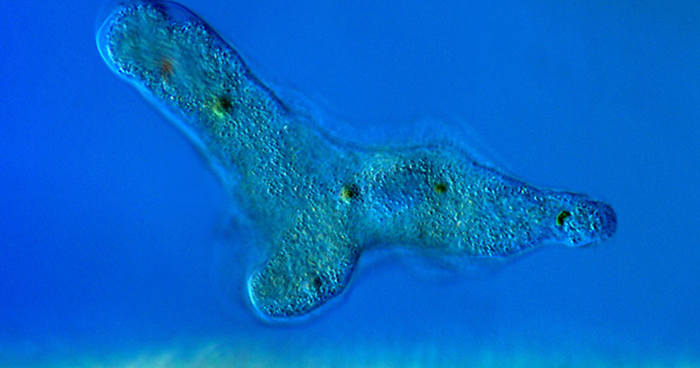
Team Leader
Masahiro Ueda
Ph.D.
Laboratory for Cell Signaling Dynamics
[Closed Mar. 2025]
E-mailmasahiroueda@riken.jp
Our group studies how signal transduction function of living cells arises spontaneously from the dynamics of intracellular reaction networks (design principles), and the mechanisms that allow these systems to process signals under the strong influence of thermal and stochastic noise (computation principles). As a typical example of stochastic biomolecular computation in living cells, we specifically focus on the gradient sensing and directional cell migration seen in the cellular slime mold Dictyostelium discoideum. In this research project, by combining advanced imaging techniques including single-molecule detection with theoretical modeling, we aim to better understand these two principles while at the same time develop the techniques necessary to do so.
Research Theme
- Spontaneous signal generation in living motile cells
- Stochastic signal transduction and processing
- Automated single-molecule imaging analysis in living cells
- Organized randomness in hierarchical structure of biological systems
Selected Publications
Miyagawa T, Koteishi H, Kamimura Y, et al.
Structural basis of Gip1 for cytosolic sequestration of G protein in wide-range chemotaxis.
Nature Communications
9, 4635 (2018)
doi: 10.1038/s41467-018-07035-x
Matsuoka S, Ueda M.
Mutual inhibition between PTEN and PIP3 generates bistability for polarity in motile cells.
Nature communications
9(1), 4481 (2018)
doi: 10.1038/s41467-018-06856-0
Yasui M, Hiroshima M, Kozuka J, et al.
Automated single-molecule imaging in living cells.
Nature Communications
9, 3061 (2018)
doi: 10.1038/s41467-018-05524-7
Yanagawa M, Hiroshima M, Togashi Y, et al.
Single-molecule diffusion-based estimation of ligand effects on G protein-coupled receptors.
Science signaling
11(548), eaao1917 (2018)
doi: 10.1126/scisignal.aao1917
Kamimura Y, Miyanaga Y, Ueda M.
Heterotrimeric G-protein shuttling via Gip1 extends the dynamic range of eukaryotic chemotaxis.
Proceedings of the National Academy of Sciences of the United States of America
113(16), 4356-4361 (2016)
doi: 10.1073/pnas.1516767113
Komatsuzaki A, Ohyanagi T, Tsukasaki Y, et al.
Compact Halo-ligand-conjugated quantum dots for multicolored single-molecule imaging of overcrowding GPCR proteins on cell membranes.
Small
11(12), 1396-1401 (2015)
doi: 10.1002/smll.201402508
Yasui M, Matsuoka S, Ueda M.
PTEN Hopping on the Cell Membrane Is Regulated via a Positively-Charged C2 Domain.
Plos Computational Biology
10(9), e1003817 (2014)
doi: 10.1371/journal.pcbi.1003817
Cai H, Katoh-Kurasawa M, Muramoto T, et al.
Nucleocytoplasmic Shuttling of a GATA Transcription Factor Functions as a Development Timer.
Science
343(6177), 1329-+ (2014)
doi: 10.1126/science.1249531
Nishikawa M, Horning M, Ueda M, Shibata T.
Excitable Signal Transduction Induces Both Spontaneous and Directional Cell Asymmetries in the Phosphatidylinositol Lipid Signaling System for Eukaryotic Chemotaxis.
Biophysical Journal
106(3), 723-734 (2014)
doi: 10.1016/j.bpj.2013.12.023
Okamoto M, Namba T, Shinoda T, et al.
TAG-1-assisted progenitor elongation streamlines nuclear migration to optimize subapical crowding.
Nature Neuroscience
16(11), 1556-1566 (2013)
doi: 10.1038/nn.3525
Matsuoka S, Shibata T, Ueda M.
Asymmetric PTEN Distribution Regulated by Spatial Heterogeneity in Membrane-Binding State Transitions.
Plos Computational Biology
9(1), e1002862 (2013)
doi: 10.1371/journal.pcbi.1002862
Nishimura SI, Ueda M, Sasai M.
Non-Brownian dynamics and strategy of amoeboid cell locomotion.
Physical Review E
85(4), 041909 (2012)
doi: 10.1103/PhysRevE.85.041909
Tsujioka M, Yumura S, Inouye K, et al.
Talin couples the actomyosin cortex to the plasma membrane during rear retraction and cytokinesis.
Proceedings of the National Academy of Sciences of the United States of America
109(32), 12992-12997 (2012)
doi: 10.1073/pnas.1208296109
Arai Y, Shibata T, Matsuoka S, et al.
Self-organization of the phosphatidylinositol lipids signaling system for random cell migration.
Proceedings of the National Academy of Sciences of the United States of America
107(27), 12399-12404 (2010)
doi: 10.1073/pnas.0908278107




